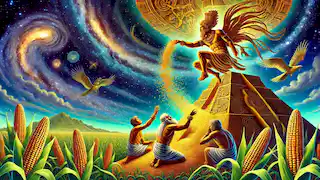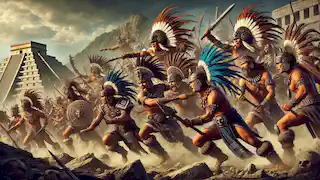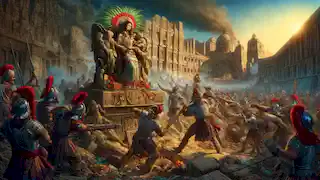In the heart of ancient Mesoamerica, the Mexica people revered a pantheon of gods, each embodying different aspects of life, death, and the cosmos. Among these deities, one stood out for his dual nature—both terrifying and life-giving. This god was Xipe Totec, the "Flayed One," whose story is a compelling tale of sacrifice, renewal, and the cyclical nature of existence. Long before the Mexica people established the grand city of Tenochtitlan, the gods gathered in the heavens to create a new world. It was during this sacred time of creation that Xipe Totec was born, a deity with skin that shimmered like golden maize. He was the god of agriculture, seasons, and renewal, but he was also the god of suffering, war, and rebirth through sacrifice. Xipe Totec's name, meaning "Our Lord the Flayed One," came from his most distinctive aspect. He wore the skin of a sacrificed individual, symbolizing the shedding of the old to make way for the new. This act was not only a reminder of the harshness of life but also of the promise of regeneration and fertility. In this early time, the gods debated the fate of humanity. The world had been created, but it was barren, without life or movement. Xipe Totec, understanding the need for balance, proposed a solution. He would offer his own life in a ritual sacrifice to bring fertility to the earth. This self-sacrifice would ensure that crops would grow, seasons would change, and life would flourish. Thus, Xipe Totec ascended the celestial pyramid, where he flayed himself, casting his skin down to the earth. As his golden flesh touched the ground, it transformed into fields of maize, the staple food of the people. The rains began to fall, and the earth burst forth with life. Through his pain and sacrifice, Xipe Totec had brought fertility and abundance to the world. Xipe Totec's influence extended far beyond agriculture. His dual nature made him a complex and revered figure in Mexica culture. On the one hand, he was the benevolent god who ensured the renewal of crops and the cycle of the seasons. On the other hand, he was also a fearsome deity associated with war, disease, and the darker aspects of life. In the great city of Tenochtitlan, Xipe Totec was honored with elaborate rituals during the festival of Tlacaxipehualiztli, which took place in the spring. This festival, whose name means "the flaying of men," was a time of great significance. Prisoners of war were sacrificed in Xipe Totec's name, their skins flayed and worn by priests to symbolize the god's regenerative powers. The ritual was brutal and terrifying, yet it was also seen as a necessary act to maintain the balance of the world. The Mexica believed that the universe was a fragile place, held together by the continuous cycle of life and death. Without sacrifice, the world would descend into chaos. Thus, through these rites, Xipe Totec was both feared and revered as the god who held the fate of humanity in his hands. The priests who donned the flayed skins became living embodiments of Xipe Totec, walking among the people as a reminder of the god's presence. These rituals also served as a way to purify the community, cleansing it of sin and ensuring the continuation of life. The skins would eventually dry and crack, symbolizing the shedding of the old and the emergence of the new—a powerful metaphor for the cycles of nature and human existence. As the god of war, Xipe Totec was deeply intertwined with the Mexica's warrior culture. Warriors who fought bravely in battle and captured prisoners for sacrifice were seen as embodying the spirit of Xipe Totec. They were celebrated as heroes, for their actions ensured the continued favor of the gods and the prosperity of the people. The warrior's path was one of honor and sacrifice, mirroring the journey of Xipe Totec. To become a warrior was to accept a life of hardship, to endure pain and suffering for the greater good. The warriors of the Mexica saw themselves as following in the footsteps of Xipe Totec, who had flayed himself for the sake of humanity. They believed that through their own sacrifices, they could achieve a form of immortality, becoming one with the god in the afterlife. In Mexica society, the highest honor was to die in battle or to be sacrificed in a ritual dedicated to Xipe Totec. Such a death was not seen as an end but as a glorious transition to a higher plane of existence. The souls of these warriors were believed to join Xipe Totec in the heavens, where they would serve as his companions and continue to protect the people. The stories of Xipe Totec and the warriors who followed him were passed down through generations, inspiring young men to take up arms and defend their city. The Mexica believed that their success in battle and the fertility of their land were directly linked to the favor of Xipe Totec. As long as they honored him through sacrifice and bravery, their society would thrive. The worship of Xipe Totec continued to play a central role in Mexica religion until the arrival of the Spanish conquistadors in the 16th century. The Spanish, horrified by the ritual sacrifices, sought to eradicate the worship of Xipe Totec and other Mesoamerican gods. They destroyed temples, banned ceremonies, and forced the people to convert to Christianity. Despite these efforts, the legacy of Xipe Totec endured. The stories and symbols of the god were passed down through generations, often blending with Christian imagery. In some regions, Xipe Totec was transformed into a syncretic figure, merging with saints and other religious figures in the new faith. The god who had once been associated with sacrifice and renewal became a symbol of resistance and survival. Even today, the figure of Xipe Totec continues to resonate in Mexican culture. He represents the idea that life is a cycle of death and rebirth, that pain and suffering can lead to growth and renewal. His story is a reminder of the deep connection between humanity and the natural world, and of the enduring power of faith and tradition. In modern times, Xipe Totec has been reinterpreted through art, literature, and cultural studies. He is often seen as a symbol of the resilience of indigenous cultures, a reminder of the rich and complex history of Mexico before the arrival of the Europeans. The flayed god, once feared and revered, has become a powerful symbol of identity and cultural pride. The story of Xipe Totec is a tale of contrasts—life and death, pain and renewal, fear and reverence. It is a story that speaks to the heart of the human experience, to the cycles of nature that govern our lives. Through the figure of Xipe Totec, the Mexica people expressed their understanding of the world, their relationship with the gods, and their place in the cosmos. Xipe Totec's legacy is one of both terror and hope. He reminds us that life is a continuous cycle, that every ending is also a beginning. The flayed god, with his golden maize and fearsome visage, continues to watch over the earth, ensuring that the cycles of life and death go on, just as they always have.The Birth of Xipe Totec

The Dual Nature of Xipe Totec

Xipe Totec and the Warrior's Path

The Legacy of Xipe Totec

Conclusion: The Eternal Cycle

The Story of Xipe Totec
Reading Time: 7 min

About Story: The Story of Xipe Totec is a Myth Stories from mexico set in the Ancient Stories. This Descriptive Stories tale explores themes of Nature Stories and is suitable for Adults Stories. It offers Cultural Stories insights. "The tale of Xipe Totec, the Flayed One, who balanced life and death in ancient Mexico.".

















